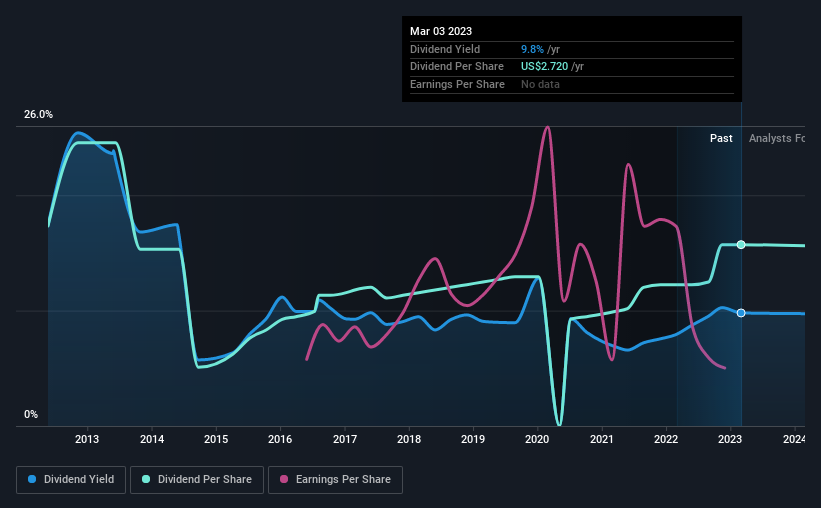- United States
- /
- Capital Markets
- /
- NYSE:SAR
Saratoga Investment (NYSE:SAR) Will Pay A Larger Dividend Than Last Year At $0.69
Saratoga Investment Corp.'s (NYSE:SAR) dividend will be increasing from last year's payment of the same period to $0.69 on 30th of March. This makes the dividend yield 9.8%, which is above the industry average.
View our latest analysis for Saratoga Investment
Saratoga Investment Is Paying Out More Than It Is Earning
A big dividend yield for a few years doesn't mean much if it can't be sustained. Prior to this announcement, the dividend made up 197% of earnings, and the company was generating negative free cash flows. Paying out such a large dividend compared to earnings while also not generating any free cash flow would definitely be difficult to keep up.
Over the next year, EPS is forecast to expand by 104.6%. If the dividend continues on its recent course, the payout ratio in 12 months could be 103%, which is a bit high and could start applying pressure to the balance sheet.

Dividend Volatility
The company's dividend history has been marked by instability, with at least one cut in the last 10 years. Since 2013, the dividend has gone from $3.00 total annually to $2.72. The dividend has shrunk at a rate of less than 1% a year over this period. Generally, we don't like to see a dividend that has been declining over time as this can degrade shareholders' returns and indicate that the company may be running into problems.
Dividend Growth Potential Is Shaky
Given that the dividend has been cut in the past, we need to check if earnings are growing and if that might lead to stronger dividends in the future. Over the past five years, it looks as though Saratoga Investment's EPS has declined at around 12% a year. A sharp decline in earnings per share is not great from from a dividend perspective. Even conservative payout ratios can come under pressure if earnings fall far enough. However, the next year is actually looking up, with earnings set to rise. We would just wait until it becomes a pattern before getting too excited.
Saratoga Investment's Dividend Doesn't Look Great
In conclusion, we have some concerns about this dividend, even though it being raised is good. The company's earnings aren't high enough to be making such big distributions, and it isn't backed up by strong growth or consistency either. Overall, the dividend is not reliable enough to make this a good income stock.
Companies possessing a stable dividend policy will likely enjoy greater investor interest than those suffering from a more inconsistent approach. However, there are other things to consider for investors when analysing stock performance. Just as an example, we've come across 4 warning signs for Saratoga Investment you should be aware of, and 3 of them are a bit concerning. If you are a dividend investor, you might also want to look at our curated list of high yield dividend stocks.
New: Manage All Your Stock Portfolios in One Place
We've created the ultimate portfolio companion for stock investors, and it's free.
• Connect an unlimited number of Portfolios and see your total in one currency
• Be alerted to new Warning Signs or Risks via email or mobile
• Track the Fair Value of your stocks
Have feedback on this article? Concerned about the content? Get in touch with us directly. Alternatively, email editorial-team (at) simplywallst.com.
This article by Simply Wall St is general in nature. We provide commentary based on historical data and analyst forecasts only using an unbiased methodology and our articles are not intended to be financial advice. It does not constitute a recommendation to buy or sell any stock, and does not take account of your objectives, or your financial situation. We aim to bring you long-term focused analysis driven by fundamental data. Note that our analysis may not factor in the latest price-sensitive company announcements or qualitative material. Simply Wall St has no position in any stocks mentioned.
About NYSE:SAR
Saratoga Investment
A business development company specializing in leveraged and management buyouts, acquisition financings, growth financings, recapitalization, debt refinancing, and transitional financing transactions at the lower end of middle market companies.
Good value average dividend payer.
Similar Companies
Market Insights
Community Narratives




